Topics
Category
Era
Minneapolis Teamsters’ Strike, 1934
National Guard troops keeping a crowd back during a raid on strike headquarters in Minneapolis, 1934.
“No trucks shall be moved! By nobody!” was the rallying cry of Minneapolis Teamsters Local 574 as they struck in the summer of 1934. Their demands were clear: a fair wage, union recognition, and the trucking firms’ recognition of inside workers as part of the union. Despite the violent reaction of the authorities, the 574 won on all these points.
In the early 1930s, an employer advocacy group called the Citizens Alliance (CA) ensured that Minneapolis remained a non-union town. President Roosevelt’s New Deal program gave workers the right to collectively bargain, and Farmer–Labor Party governor Floyd Olson sympathized with unions. Olson’s support, however, proved tepid at best, and the bosses felt the New Deal did not mandate unions. Additionally, large labor groups were more interested in maintaining the status quo than in improving working conditions.
Instead, Local 574 conducted a grass-roots campaign that won the hearts of the rank and file. The organizers were workers themselves, and relied on strong personal connections to develop their plans. Many of those leaders—V. R. Dunne and Carl Skoglund in particular—also belonged to the Trotskyist Communist League, which taught them how to strategize a radical strike. Smart planning, strong leadership, and member loyalty would carry the day.
In February, Local 574 organized and won a coal truckers’ strike for union recognition and better working conditions. Though the gains were minor, the real boost came from the confidence it built among workers. Over the next few months the 574’s ranks swelled with members joining up from all sectors of the trucking industry.
An industry-wide union that included truckers, helpers, and inside workers like packers was unprecedented and entailed a great amount of power. They mobilized for an inevitable strike, creating a radicalized workers’ organizing committee. A strike headquarters was rented and furnished with a commissary, a garage, and medical staff. The 574 also created a women’s auxiliary that included members’ wives and boosted morale.
On April 30, workers demanded a closed shop, union recognition, shorter hours, and standard pay. The 574 presented these demands to the trucking firms, which refused to negotiate with or recognize the union. The workers thus voted to strike on May 16.
Right away there were violent skirmishes between strikers and the “special deputies” who had been organized by police chief Michael Johannes and the CA. These clashes proved inconclusive until the “Battle of Deputies’ Run” on May 22, during which the workers beat and dispersed the strikebreakers, killing two.
Under pressure from the governor, the two sides agreed to a deal on May 25: all workers would be reinstated and the 574 would represent truckers and helpers. Yet the definition of “insider workers” was left open.
By June things were unraveling. The CA leaned on employers to discriminate against union members. The bosses refused to discuss wages or the inside-worker issue with the union.
Workers voted to strike starting July 16. Johannes in turn issued shotguns to the strikebreaking forces and encouraged their use. On July 20, “Bloody Friday,” police opened fire on unarmed strikers attempting to stop a delivery. Sixty-seven people were wounded—most of them shot in the back. Two were killed, including one man whose funeral became a mass demonstration; an estimated forty thousand marched.
On July 25, mediators Francis J. Haas and E.H. Dunnigan issued a proposal that listed minimum wage rates and clearly defined insider workers; it also reaffirmed union recognition. Local 574 accepted the deal but the firms—many of them now represented by the Employers’ Adivsory Committee or EAC—rejected it.
Olson declared martial law, banning picketing and issuing permits only to trucks delivering essentials. The National Guard raided CA and strike headquarters and arrested union leaders. The permit system quickly relaxed. Firms began to deliver wares, causing 574 president Bill Brown to claim that the governor was “the best strikebreaking force our union has ever gone up against.”
On August 5, Olson allowed only those firms that signed the Haas-Dunnigan proposal to get trucking permits. Under pressure, the EAC finally voted to accept it. The strike ended on August 22, 1934.
The Citizens’ Alliance’s iron grip had been broken. Minneapolis’s notoriety as a “scab” town was replaced by a reputation for union support.
Bibliography
Dobbs, Farrell. Teamster Rebellion. New York: Monad Press, 1972.
Korth, Philip A. The Minneapolis Teamsters Strike of 1934. East Lansing, MI: Michigan State University Press, 1995.
Walker, Charles R. American City: A Rank and File History of Minneapolis. Minneapolis: University of Minnesota Press, 2005.
Related Resources
Primary
Dunne, William F. Permanent Counter-Revolution: The Role of the Trotzkyites in the Minneapolis Strikes. New York: Workers Library, 1934.
M494
Minneapolis Teamsters Strike, 1934: Selected Documents, 1928–1941
Manuscript Collection, Minnesota Historical Society, St. Paul
Description: Correspondence, telegrams, clippings, reports, speeches, legal agreements, broadsides, and other printed matter documenting the 1934 Minneapolis teamsters strike.
OH 73
Oral history interview with Vincent Raymond Dunne, April 27, 1969
Oral History Collection, Minnesota Historical Society, St. Paul
http://collections.mnhs.org/cms/display.php?irn=10446082
Description: Interview with Vincent Raymond Dunne, an organizer of the 1934 Teamsters' strike.
OH 30
Twentieth Century Radicalism in Minnesota Oral History Project: Interview with Carl Skoglund, 1955-1959
Oral History Collection, Minnesota Historical Society, St. Paul
http://collections.mnhs.org/cms/display.php?irn=10362561
Description: Interview with Carl Skoglund, an organizer of the 1934 Teamsters' strike.
OH 30
Twentieth Century Radicalism in Minnesota Oral History Project: Interview with Harry DeBoer, Pauline DeBoer, and Jake Cooper, March 14-June 22, 1988
Oral History Collection, Minnesota Historical Society, St. Paul
http://collections.mnhs.org/cms/display.php?irn=10362512
Description: Interview with Harry DeBoer, a participant in the 1934 Teamsters' strike.
OH 30
Twentieth Century Radicalism in Minnesota Oral History Project: Interview with Jack Maloney, April 21 and 25, 1988
Oral History Collection, Minnesota Historical Society, St. Paul
http://collections.mnhs.org/cms/display.php?irn=10362540
Description: Interview with Jack Maloney, an organizer of the 1934 Teamsters' strike.
The Minneapolis Organizer, 1934
Description: The Minneapolis Organizer was the official paper of Local 574 published during the strike. It was the first paper ever published by a striking union in the United States.
“Truckers Strike, Minneapolis.” 16mm film. N.p.: 1934.
Editor’s Note: This film is available for viewing at the Minnesota Historical Society, St. Paul, Minnesota.
Secondary
Blantz, Thomas E. “Father Haas and the Minneapolis Truckers’ Strike of 1934.” Minnesota History 42 no. 1 (Spring 1970): 5–15.
http://collections.mnhs.org/MNHistoryMagazine/articles/42/v42i01p005-015.pdf
Diehl-Taylor, Christiane. Partners in the Struggle: the Role of Women’s Auxiliaries and Brigades in the 1934 Minneapolis Truck Drivers Strikes and the 1936/37 Flint General Motors Sit-Down Strike. Typescript, [1990].
Dobbs, Farrell. Teamster Power. New York: Monad Press, 1973.
Gieske, Millard L. Minnesota Farmer-Laborism: The Third-Party Alternative. Minneapolis: University of Minnesota Press, 1979.
Korth, Philip A. “Strike! A History of the Minneapolis Truck Drivers’ Strikes of 1934.” Master’s Thesis, University of Minnesota, 1963.
Lynd, Staughton, ed. “We Are All Leaders”: The Alternative Unionism of the Early 1930s. Urbana, IL: University of Illinois Press, 1996.
Mayer, George H. The Political Career of Floyd B. Olson. Minneapolis: University of Minnesota Press, 1951.
Ostenby, Peter M. Shaking the Foundations: A Study of the Origins, Events, and Consequences of the Minneapolis Trucker’s Strikes of 1934. Typescript, 1985.
Palmer, Bryan D. Revolutionary Teamsters: The Minneapolis Truckers’ Strikes of 1934. Chicago: Haymarket Books, 2014.
Sachs, David A. Trotskyism and the Minneapolis Teamsters Movement. Typescript, 1962.
Schultz, Robert T. Conflict and Change: Minneapolis Truck Drivers Make a Dent in the New Deal. Prospect Heights, IL: Waveland Press, 2000.
Related Audio
MN90: Union Victory in Minneapolis
Minneapolis was a notorious anti-union town in the early 1900s. But a series of truckers’ strikes in 1934 turned the city into one of the most powerful union cities in the United States. MN90 producer Marisa Helms reports that the strikes were part of a wave of union actions across the country and spurred passage of the 1935 Wagner Act.
All rights reserved
Articles
Related Images
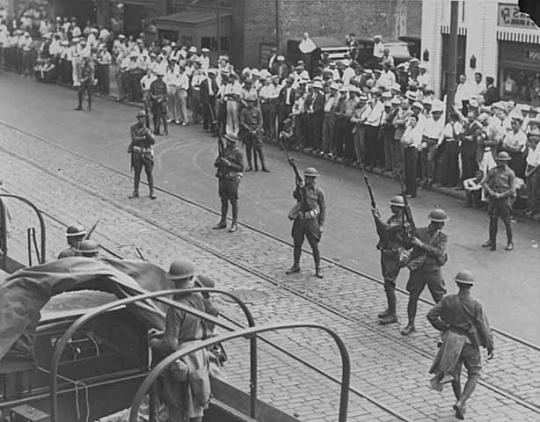
National Guardsmen at the truck drivers’ strike, Minneapolis
National Guard troops keeping a crowd back during a raid on strike headquarters in Minneapolis, 1934.
Holding Location
Articles
More Information
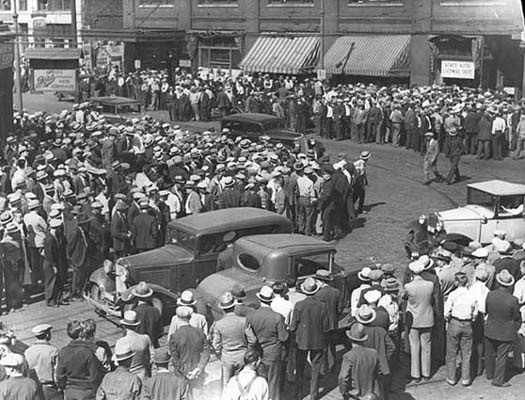
Truck drivers’ strike, Minneapolis
Street scene, Truck drivers’ strike, 1934.
Holding Location
Articles
More Information
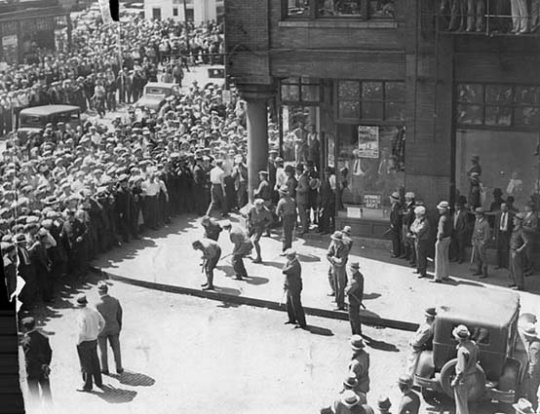
Truck drivers' strike, Minneapolis
Street scene, truck drivers' strike, 1934.
Holding Location
Articles
More Information
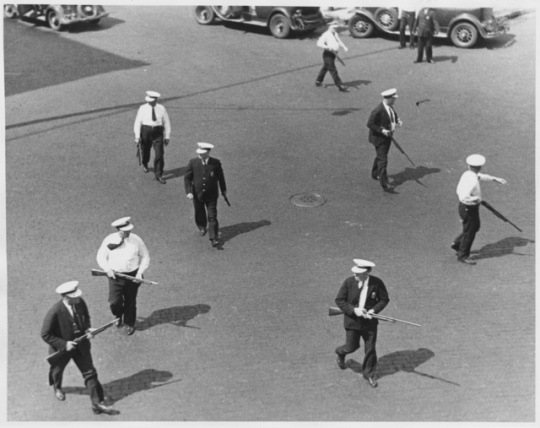
Police with guns on a Minneapolis street during the truckers’ strike
Police carrying shotguns during the truck drivers’ strike, 1934.
Holding Location
Articles
More Information
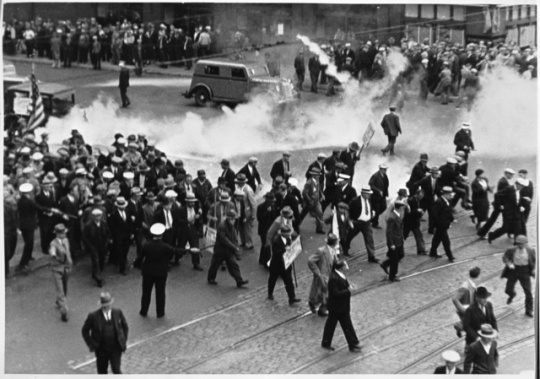
Using tear gas during the truckers' strike, Minneapolis
Tear gas being used on demonstrators during the truck drivers’ strike, 1934.
Holding Location
More Information
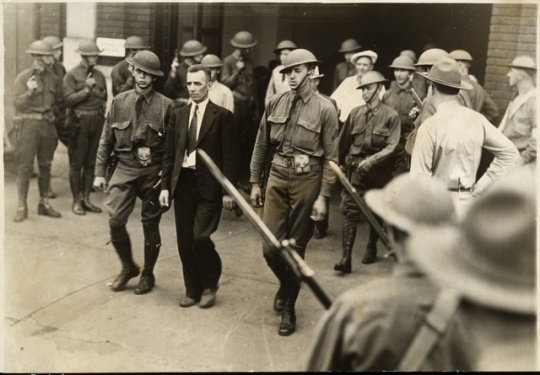
Vincent R. Dunne, strike leader, held under guard
Vincent R. Dunne, strike committee member, arrested and held at the provost guard stockade at the state fairgrounds, 1934.
Holding Location
More Information
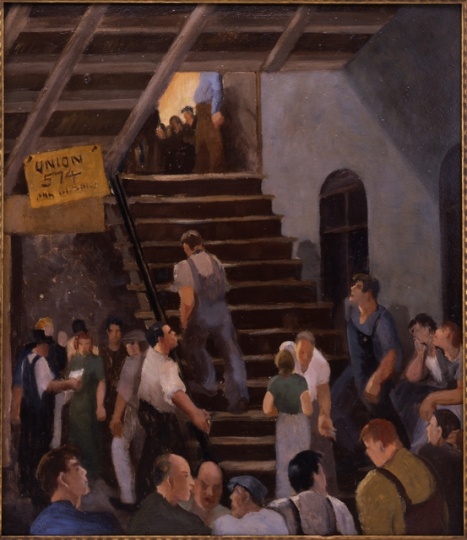
Painting of strike headquarters
Oil on board painting of strike headquarters, 1934. Painting by Jerry Hudson.
Holding Location
Articles
More Information
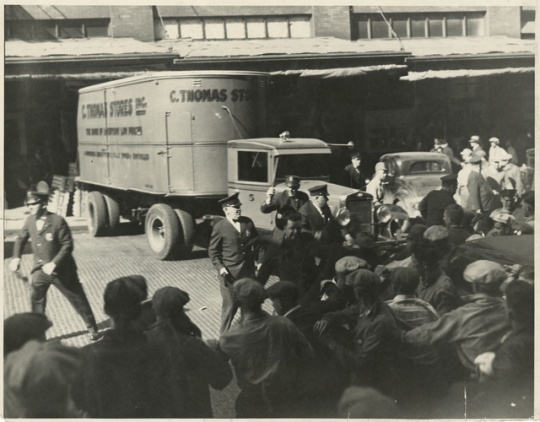
Police and strikers
Police and strikers, 1934.
Holding Location
Articles
More Information
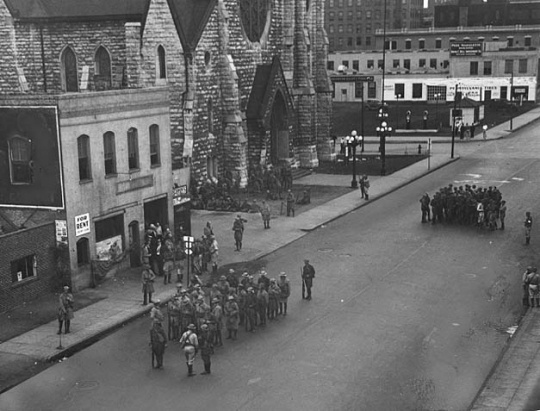
Strike headquarters
Strike headquarters, 1934.
Holding Location
Articles
More Information
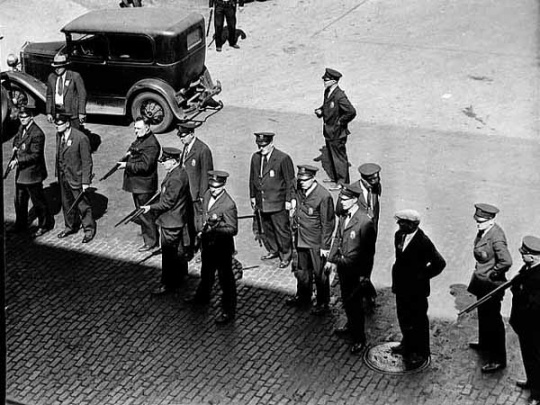
Police with guns during the truckers’ strike
Police with guns on a Minneapolis street during the strike, 1934.
Holding Location
Articles
More Information
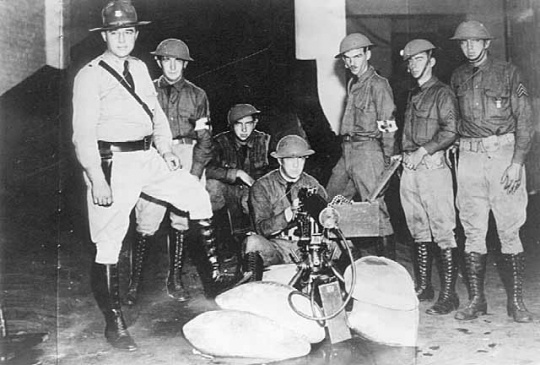
National Guard at truckers’ srike
Minnesota National Guard at the truck drivers' strike, Minneapolis, 1934.
Holding Location
Articles
More Information
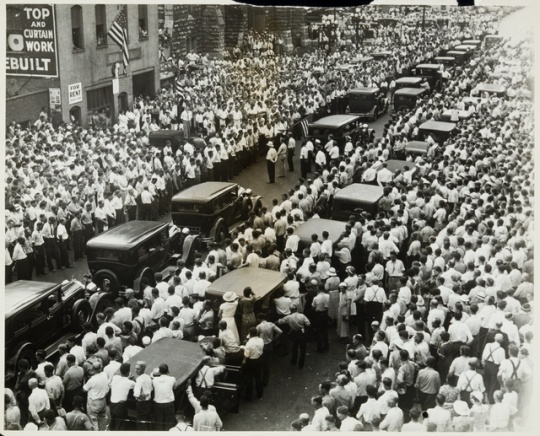
Funeral of Henry Ness
Funeral of Henry Ness, a striker killed during the strike, in front of strike headquarters at 215 South Eighth Street, Minneapolis, 1934.
Holding Location
Articles
Related Articles
Turning Point
On July 20, 1934, “Bloody Friday”, police open fire on unarmed strikers, wounding sixty-seven and killing two. The event garners strong public support for the workers and pressures employers to settle the strike.
Chronology
February 9, 1934
May 16
May 22
June 25
July 17
July 20
July 25
July 26
August 1
August 3
August 21
August 22
Bibliography
Dobbs, Farrell. Teamster Rebellion. New York: Monad Press, 1972.
Korth, Philip A. The Minneapolis Teamsters Strike of 1934. East Lansing, MI: Michigan State University Press, 1995.
Walker, Charles R. American City: A Rank and File History of Minneapolis. Minneapolis: University of Minnesota Press, 2005.
Related Resources
Primary
Dunne, William F. Permanent Counter-Revolution: The Role of the Trotzkyites in the Minneapolis Strikes. New York: Workers Library, 1934.
M494
Minneapolis Teamsters Strike, 1934: Selected Documents, 1928–1941
Manuscript Collection, Minnesota Historical Society, St. Paul
Description: Correspondence, telegrams, clippings, reports, speeches, legal agreements, broadsides, and other printed matter documenting the 1934 Minneapolis teamsters strike.
OH 73
Oral history interview with Vincent Raymond Dunne, April 27, 1969
Oral History Collection, Minnesota Historical Society, St. Paul
http://collections.mnhs.org/cms/display.php?irn=10446082
Description: Interview with Vincent Raymond Dunne, an organizer of the 1934 Teamsters' strike.
OH 30
Twentieth Century Radicalism in Minnesota Oral History Project: Interview with Carl Skoglund, 1955-1959
Oral History Collection, Minnesota Historical Society, St. Paul
http://collections.mnhs.org/cms/display.php?irn=10362561
Description: Interview with Carl Skoglund, an organizer of the 1934 Teamsters' strike.
OH 30
Twentieth Century Radicalism in Minnesota Oral History Project: Interview with Harry DeBoer, Pauline DeBoer, and Jake Cooper, March 14-June 22, 1988
Oral History Collection, Minnesota Historical Society, St. Paul
http://collections.mnhs.org/cms/display.php?irn=10362512
Description: Interview with Harry DeBoer, a participant in the 1934 Teamsters' strike.
OH 30
Twentieth Century Radicalism in Minnesota Oral History Project: Interview with Jack Maloney, April 21 and 25, 1988
Oral History Collection, Minnesota Historical Society, St. Paul
http://collections.mnhs.org/cms/display.php?irn=10362540
Description: Interview with Jack Maloney, an organizer of the 1934 Teamsters' strike.
The Minneapolis Organizer, 1934
Description: The Minneapolis Organizer was the official paper of Local 574 published during the strike. It was the first paper ever published by a striking union in the United States.
“Truckers Strike, Minneapolis.” 16mm film. N.p.: 1934.
Editor’s Note: This film is available for viewing at the Minnesota Historical Society, St. Paul, Minnesota.
Secondary
Blantz, Thomas E. “Father Haas and the Minneapolis Truckers’ Strike of 1934.” Minnesota History 42 no. 1 (Spring 1970): 5–15.
http://collections.mnhs.org/MNHistoryMagazine/articles/42/v42i01p005-015.pdf
Diehl-Taylor, Christiane. Partners in the Struggle: the Role of Women’s Auxiliaries and Brigades in the 1934 Minneapolis Truck Drivers Strikes and the 1936/37 Flint General Motors Sit-Down Strike. Typescript, [1990].
Dobbs, Farrell. Teamster Power. New York: Monad Press, 1973.
Gieske, Millard L. Minnesota Farmer-Laborism: The Third-Party Alternative. Minneapolis: University of Minnesota Press, 1979.
Korth, Philip A. “Strike! A History of the Minneapolis Truck Drivers’ Strikes of 1934.” Master’s Thesis, University of Minnesota, 1963.
Lynd, Staughton, ed. “We Are All Leaders”: The Alternative Unionism of the Early 1930s. Urbana, IL: University of Illinois Press, 1996.
Mayer, George H. The Political Career of Floyd B. Olson. Minneapolis: University of Minnesota Press, 1951.
Ostenby, Peter M. Shaking the Foundations: A Study of the Origins, Events, and Consequences of the Minneapolis Trucker’s Strikes of 1934. Typescript, 1985.
Palmer, Bryan D. Revolutionary Teamsters: The Minneapolis Truckers’ Strikes of 1934. Chicago: Haymarket Books, 2014.
Sachs, David A. Trotskyism and the Minneapolis Teamsters Movement. Typescript, 1962.
Schultz, Robert T. Conflict and Change: Minneapolis Truck Drivers Make a Dent in the New Deal. Prospect Heights, IL: Waveland Press, 2000.













